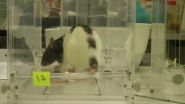(Press-News.org) Researchers from Case Western Reserve University in Cleveland have discovered that populating the gastrointestinal (GI) tracts of mice with Bacteroides species producing a specific enzyme helps protect the good commensal bacteria from the harmful effects of antibiotics. Their research is published ahead of print in Antimicrobial Agents and Chemotherapy.
Antibiotics are powerful weapons against pathogens, but most are relatively indiscriminate, killing the good bacteria, along with the bad. Thus, they may render patients vulnerable to invasion, particularly by virulent, antibiotic-resistant pathogens that frequently populate hospitals.
The novel aspect of the research is that the enzyme produced by these bacteria, beta-lactamase, is a major cause of antibiotic resistance, says first author, Usha Stiefel. Interestingly, the enzyme is not only protecting the bacteria that produce it but also the rest of the bacteria making up the intestinal microbiome.
In the study, the investigators established populations of beta-lactamase producing Bacteroides in some mice, but not others. They then gave all the mice ceftriaxone, a beta-lactam antibiotic, for three days and then oral doses of vancomycin-resistant enterococcus, or Clostridium difficile, both of which are virulent GI pathogens.
The mice that had been populated with Bacteroides maintained their diverse species of commensal gut bacteria, free of pathogens, while the control mice saw their commensals decimated by antibiotics, enabling establishment of the pathogens.
"When patients in the hospital or nursing home setting receive antibiotics, it is doubly dangerous when they lose their native colonic bacteria, because healthcare settings are full of resistant or particularly virulent bacteria, and so patients are especially vulnerable to acquiring these bacteria within their intestinal tracts," says Stiefel.
Since the Bacteroides, which comprise roughly one quarter of the intestinal microbiome, are absent elsewhere in the body, the investigators believe that the beta-lactamase will not interfere with treatment of infections in other organ systems, such as in the respiratory tract, or the blood, explains Stiefel.
"The results of our study are exciting because they show how it might be possible to take antibiotics without suffering from the loss of your colonic microbiome and then becoming colonized by virulent pathogens," says Stiefel. For example, beta-lactamase enzymes could be given orally as drugs, to protect the gut bacteria from systemic antibiotics. Alternatively, as with the mice, patients' GI tracts might be populated with antibiotic-degrading bacteria.
One weakness of the strategy is that while it could protect against acquiring a GI infection, C. difficile, for example, it could not be used to combat such an infection.
"The recognition of the importance of an intact and diverse microbiome has probably best been demonstrated by the successful treatment of Clostridium difficile colitis by fecal microbiota transplantation, or 'stool transplant,'" says Stiefel. "If you have an intact intestinal microbiome, you simply are going to be resistant to acquiring many types of infection."
"If we can find ways to preserve the microbiome in hospitalized patients who are receiving antibiotics, we are on our way to preventing a large proportion of hospital-acquired infections," says Stiefel.
INFORMATION:
The manuscript can be found online at http://bit.ly/asmtip0614d. The final version of the article is scheduled for the August 2014 issue of Antimicrobial Agents and Chemotherapy.
Antimicrobial Agents and Chemotherapy is a publication of the American Society for Microbiology (ASM). The ASM is the largest single life science society, composed of over 39,000 scientists and health professionals. Its mission is to advance the microbiological sciences as a vehicle for understanding life processes and to apply and communicate this knowledge for the improvement of health and environmental and economic well-being worldwide.
Good bacteria armed with antibiotic resistance protect gut microbiome
2014-06-12
ELSE PRESS RELEASES FROM THIS DATE:
Neural reward response may demonstrate why quitting smoking is harder for some
2014-06-12
For some cigarette smokers, strategies to aid quitting work well, while for many others no method seems to work. Researchers have now identified an aspect of brain activity that helps to predict the effectiveness of a reward-based strategy as motivation to quit smoking.
The researchers observed the brains of nicotine-deprived smokers with functional magnetic resonance imaging (fMRI) and found that those who exhibited the weakest response to rewards were also the least willing to refrain from smoking, even when offered money to do so.
"We believe that our findings may ...
Proteins causing daytime sleepiness tied to bone formation, target for osteoporosis
2014-06-12
DALLAS – June 12, 2014 – Orexin proteins, which are blamed for spontaneous daytime sleepiness, also play a crucial role in bone formation, according to findings by UT Southwestern Medical Center researchers. The findings could potentially give rise to new treatments for osteoporosis, the researchers say.
Orexins are a type of protein used by nerve cells to communicate with each other. Since their discovery at UT Southwestern more than 15 years ago, they have been found to regulate a number of behaviors, including arousal, appetite, reward, energy expenditure, and wakefulness. ...
Long-range tunneling of quantum particles
2014-06-12
This news release is available in German. One of the most remarkable consequences of the rules in quantum mechanics is the capability of a quantum particle to penetrate through a potential barrier even though its energy would not allow for the corresponding classical trajectory. This is known as the quantum tunnel effect and manifests itself in a multitude of well-known phenomena. For example, it explains nuclear radioactive decay, fusion reactions in the interior of stars, and electron transport through quantum dots. Tunneling also is at the heart of many technical ...
Vast genetic diversity among Mexicans found in large-scale study
2014-06-12
The first large-scale, comprehensive analysis of the genomic diversity of Mexico — led by researchers at the Stanford University School of Medicine, the University of California-San Francisco and the Mexican National Institute of Genomic Medicine — has identified a dazzling mosaic of genotypes and population substructures across the country.
Some groups are as genetically different from one another as Europeans are from East Asians.
The study, which will be published June 13 in Science, soundly refutes the current practice of lumping together Mexicans or Latinos as ...
Broad Institute, MGH researchers chart cellular complexity of brain tumors
2014-06-12
Scientists from the Broad Institute and Massachusetts General Hospital (MGH) have conducted a first-of-its-kind study that characterizes the cellular diversity within glioblastoma tumors from patients. The study, which looked at the expression of thousands of genes in individual cells from patient tumors, revealed that the cellular makeup of each tumor is more heterogeneous than previously suspected. The findings, which appear online in Science Express, will help guide future investigations into potential treatments for this devastating disease.
This is the first time ...
Mexican genetics study reveals huge variation in ancestry
2014-06-12
In the most comprehensive genetic study of the Mexican population to date, researchers from UC San Francisco and Stanford University, along with Mexico's National Institute of Genomic Medicine (INMEGEN), have identified tremendous genetic diversity, reflecting thousands of years of separation among local populations and shedding light on a range of confounding aspects of Latino health.
The study, which documented nearly 1 million genetic variants among more than 1,000 individuals, unveiled genetic differences as extensive as the variations between some Europeans and Asians, ...
Father's age influences rate of evolution
2014-06-12
The offspring of chimpanzees inherit 90% of new mutations from their father, and just 10% from their mother, a finding which demonstrates how mutation differs between humans and our closest living relatives, and emphasises the importance of father's age on evolution.
Published today in Science, researchers from the Wellcome Trust Centre for Human Genetics and the Biomedical Primate research Centre in the Netherlands looked at whether, in chimpanzees, there was a heightened risk of fathers passing on mutations to their children compared to humans.
In humans, each individual ...
New evidence for oceans of water deep in the Earth
2014-06-12
Researchers from Northwestern University and the University of New Mexico report evidence for potentially oceans worth of water deep beneath the United States. Though not in the familiar liquid form -- the ingredients for water are bound up in rock deep in the Earth's mantle -- the discovery may represent the planet's largest water reservoir.
The presence of liquid water on the surface is what makes our "blue planet" habitable, and scientists have long been trying to figure out just how much water may be cycling between Earth's surface and interior reservoirs through ...
With the right rehabilitation, paralyzed rats learn to grip again
2014-06-12
VIDEO:
This video depicts Restored grasping after immunotherapy and rehabilitative training.
Click here for more information.
Only if the timing, dosage and kind of rehabilitation are right can motor functions make an almost full recovery after a large stroke. Rats that were paralyzed down one side by a stroke almost managed to regain their motor functions fully if they were given the ideal combination of rehabilitative training and substances that boosted the growth of nerve fibers. ...
Unexpected origin for important parts of the nervous system
2014-06-12
A new study from Karolinska Institutet in Sweden shows that a part of the nervous system, the parasympathetic nervous system, is formed in a way that is different from what researchers previously believed. In this study, which is published in the journal Science, a new phenomenon is investigated within the field of developmental biology, and the findings may lead to new medical treatments for congenital disorders of the nervous system.
Almost all of the body's functions are controlled by the autonomous, involuntary nervous system, for example the heart and blood vessels, ...



